
 |
How it works : Physics |
PHYSICS
To many people, physics is science. All the most famous names in science-Newton, Galileo, Einstein, Archimedes, for example belong to people whose major discoveries were in physics. Physics is concerned with the laws that govern Nature-in other words MATTER and ENERGY. CHEMISTRY, which is concerned with the composition of substances and their interaction with each other, is considered to be a separate subject, but it has relied heavily on advances in physics to clarify and explain the constituents of matter and their subsequent interaction on the chemical level. The same is true for biology and biochemistry; in fact, physics pervades our under standing of the Universe and of life.
|
Left: early Greek scientific thought in Athens followed Plato's
deductive approach: 'Astronomy, then, like geometry we shall pursue by the
help of problems and leave the starry heavens alone.' Left: another school of Greek thought arose later in Alexandria which followed the empirical approach of Aristotle; such technological achievements as Hero's embryonic steam engine had been developed by the 1st century AD. |
|
The rise of physics
Something like half a million years ago our pre-human ancestors were
already using simple hand-made tools and fire; the palaeolithic men who made
the famous cave paintings had bows and arrows some 20,000 years ago, and
even today there are still races whose technology is still at the Stone Age
level of evolution. By 10,000 years ago, the first farmers were tilling the
soil, and 5000 years ago the signs of basic science were emerging in Babylonia.
Despite some laws discovered by the Greeks, technology in everyday life was
very much the same in the Middle Ages as it was in Roman times-indeed, the
Romans had better plumbing. It was not until the 17th century
that science as we know it really got under way; then in the 18th
and 19th centuries came the industrial revolution,
and in the zoth century physics plays such a large pait in our lives that
it takes a considerable effort to adopt a life style which does not depend
on it. It was in the 17th century that the real beginnings
of 'classical' physics came. GALILEO, KEPLER, BOYLE,
NEWTON, HOOKE, HUYGENS, GUERICKE, TORRICELLI-these
men and many others all laid the foundations of physics. By this time the
level of civilization had risen sufficiently for this to become possible.
The 17th century also saw a divergence between philosophy and physics. Physics was then called natural philosophy-this is why doctors of science are given the title 'Ph D' --'doctor of philosophy'. While Galileo got into trouble with the Church for his notions which were opposed to the doctrines of Aristotle, the northern European schools of science no longer had to worry about whether 'heir findings were philosophicallv acceptable.
Scientific method
The scientific method is not an infallible way of finding out the
truth: sometimes it fails completely, and what is needed is some tare insight
to interpret the results in a new way. The basis of the method, though, lies
in experimentation or observation; recording the results accurately; the
assumption of cause and effect-that every
natural phenomenon has a cause which must be investigated; the forming of
a theory; and the use of that theory to make predictions about the behaviour
of other things.
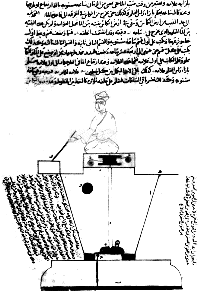 |
|
The principle of cause and effect, while it seems to be a perfectly obvious notion, was not always recognized as such. Early explanations of natural phenomena usually involved the action of a god, and while it is true that modern physics merely pushes the level of understanding rather deeper, the point is that one should always try to find out a more underlying cause.
The first people to record the phenomena around them were the Babylonians, living between the rivers of Tigris and Euphrates, in what,is present day Iraq, around 3000 BC. They had the use of writing, and catalogued the motions of the heavenly bodies. The stone circles of north western Europe, such as STONEHENGE, show that the inhabitants of that part of the world, at atound the same time, were trying to do the same thing despite their lack of writing, by laying out an analogue of the celestial motions on the ground.
The Babylonian and early Egyptian records came down to the Greeks, who first attempted to establish some sort of order. Some elementary notions in mechanics and statics-such as ARCHIMEDES' famous bath episode, and his lever experiments-were laid down. The most important contribution the Greeks made was to establish some principles of MATHEMATICS, which has played an essential part in the development of physics. The actual techniques of algebra on which physics is based did not come along until rather later, though the basics were laid down by Diophantus at the end of the 3rd century AD.
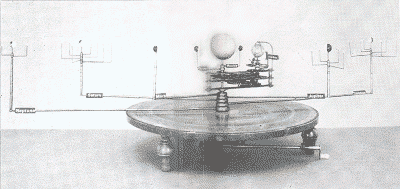 |
| The 17th century saw major advances on two fronts: celestial
geometry and mechanics.Above: Kepler reordered the solar system and placed
the sun at its centre,' he also devised mathematical laws to predict the
motion of the planets. Shown here is an orrery. |
After the Greeks, it was the Arabs who took over the development of science. Some original ideas can be traced back to the Arab scholars, particularly al-Haytham's work in OPTICS, and in the symbols used for mathematics, but by and large they merely kept the fire alight until the growth of European learning, first in Italy and then in northern Europe.
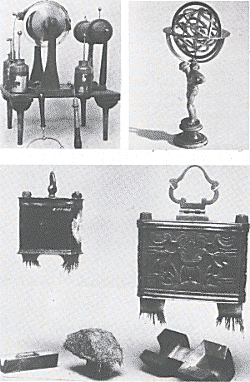 |
Contemporary theories of celestial mechanics: Descartes'
vortex theorem and Newton's laws of motion . |
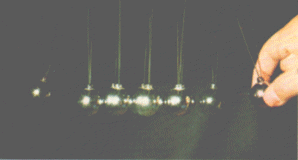 |
Seventeenth century
Galileo (1564-1642) was the first physicist of note. His basic experiments
in dynamics, and his use of such primary instruments as the TELESCOPE,
MICROSCOPE and THERMOMETER, were the first shot in the battle
against the dogmas of the Greek Aristotle.
It was Galileo who first talked lucidly in terms of forces and motions of bodies which could be measured. He took the first steps towards finding the laws which related these quatities,rather than just saying,as Aristotle did, that stones fall to the ground, and heavier stones fall faster than lighter ones. Galileo proved Aristotle wrong on this count, and showed how one could calculate the way in which stones do fall.
After Galileo came the work of Newton, Huygens, Boyle and so on. The principal centre was the Royal Society in London, of which all these men were Fellows. Apart from physicists there were such names as Edmond Halley the astronomer, Christopher Wren the astronomer and architect, Evelyn and Pepys the diarists, and John Locke the philosopher.
Newton's work on dynamics, mathematics and optics led the way; in fact he laid the foundations of physics. He found that there is a constant factor which must be included in any equation concerning gravity: what we now call the gravitational constant, G. This was the first of three constants which are essential to our understanding of the properties of matter.
Eighteenth century
For the next century or so, scientists consolidated Newtonian (or
'classical') physics, and a textbook on mechanics and dynamics would contain
pretty much the same sort of information as one today. 18th century research
concentrated on research into heat and its effects, leading up to the development
of steam engines, and the first links between science and technology. It
also saw the first experiments in static electricity by FRANKLIN and
COULOMB.
Nineteenth century In the early 19th century a much more important discovery was made: current electricity was produced and studied by VOLTA, OERSTED, AMPERE and OHM, including its links with magnetism for which FARADAY is famous. This all culminated in MAXWELL'S equations in the 1860s, linking, such apparently diverse phenomena as ELECTRICITY, MAGNETISM and LIGHT. Maxwell's equations show that there is another important constant, the speed of light, c.
The increasing use of steam engines in the 19th century led to investigations into the relationships between heat, work and energy. Sadi CARNOT first established that work and heat are linked, the essence of the science of THERMODYNAMICS. The mechanical equivalent of heat was studied by JOULE, and was followed up by Helmholtz and Lord KELVIN.
After this, it was believed that physics was essentially complete, and that all that had to be done was to tie up a few loose ends and calculate everything to a few more decimal places. Sadly for this view, some of the loose ends proved remarkably difficult to tie up, such as the distribution of the light emitted by glowing incandescent bodies.
| Below: in the 19th century, Maxwell umfied electricity
and magnetism. Shown here is an early use in the synthesis of sound. |
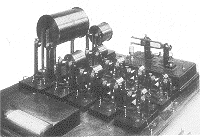 |
20th century physics
According to the classical theory, there should be more and more energy
given off as one looks further and further towards the ultra-violet end of
the spectrum. This does not happen-something seems to be limiting the amount
of short wavelengths emitted, which avoids what would be an 'ultra-violet
catastrophe'.
Max PLANCK suggested that all this could be explained if energy comes in discrete 'packets' or quanta, just as matter is not continuous but is composed of atoms. The QUANTUM nature of radiation is the limiting factor. Einstein went on to show that this idea tied up some other loose ends as well, such as the PHOTOELECTRIC effect.
Others, notably BOHR and RUTHERFORD, extended its mfluence to the field of atomic physics, showing how the electrons exist only in certain energy levels, governed by the third basic constant, Planck's constant, h. Maxwell's work was not overthrown, but merely amended.
Far from rounding off classical physics, these discoveries opened up the 'new physics'. This took into account all the work on radioactivity done by people such as BECQUEREL and the CURIES, and linked them with the discovery of the electron by J J THOMSON. This, together with Einstein's theory of RELATIVITY which takes over from Newtonian mechanics at speeds approaching that of light, led via the famous equation E = mc2 to atomic power.
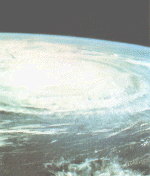 Future
developments
Future
developments
Physicists no longer believe that all they have to do is to calculate
things to more decimal places, though it is generally accepted that our knowledge
of basic physics is now unlikely to suffer any upheavals. Fundamental research
today is in two apparently widely separated fields, those of PARTICLE
PHYSICS and astronomy.
In particle physics, attempts are being made to find the most elementary particles, which all other matter consists of and to perceive how they interact. In astronomy, it is possible to study matter on a large scale, under conditions impossible to reproduce on Earth, and at very early times in the history of the Universe, as a result of the time taken for the light to reach us from distant objects.
The light from the stars is produced by thermonuclear reac tions taking place at a microscopic level, though involving vast numbers of atoms. The action of the weakest force FIELD known, the gravitational force, only manifests itself over astronomical distances. Attempts are currently being made to find a unified field theory, which will link all the four force fields known, and will maybe explain why the constants G, c and h have their particular values.
It is possible that in the process of doing this, new fields and constants will turn up, revealing new aspects of physics which are as yet unsuspected.
Reproduced from HOW IT WORKS p1746